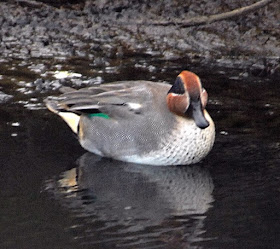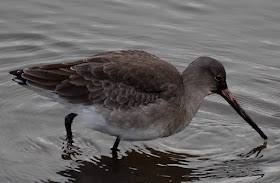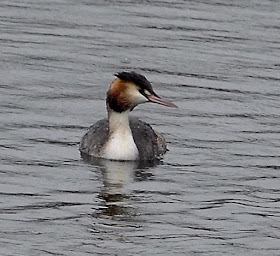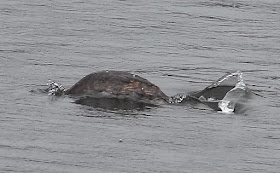On Friday, Gary and I noted a black tailed godwit at Titchwell that had a series of coloured rings on either leg. The colour combination is unique to that specific bird and so reported this to the coordinator at the University of East Anglia, Professor Jenny Gill. She kindly forwarded the information to the ringer in Iceland and I have just received this fascinating insight into the travels of this female bird since it was first ringed in 2012. Certainly has travelled a fair few thousand miles since 2012 and shown a preference for overwintering in Norfolk having first experienced Leighton Moss in Lancashire in 2013.
Presumably, although not shown here apart from 2013, she returns to Iceland each spring to breed before returning to the UK in July.
Note the similarity of dates: 18th August 2014, arrives in The Wash. 17th August 2015, arrives in The Wash! Birds continue to amaze me. It will be interesting to see if this bird continues to overwinter at Titchwell, before heading off to breeding grounds around mid March 2016. It is an easy bird to spot with the 4 rings visible, even in flight.
I am always intrigued by ringing data, even a stonechat I recorded at Kelling Water meadows. Sent off the relevant data and discovered it was ringed as a nestling, was 3 years old and in that time, had travelled 400 yards!
Edit: Just calculated that the distance covered in just the records shown here is in excess of 9250 miles from June 2012 to November 2015. Black tailed godwits can live for 25 years, so, working on an average of 2300 miles per year, just in moving sites and not winging around on a daily basis, for 20 years the distance covered will be 46,000miles! Startling.
Graham Appleton frequently updates a really interesting blog on wader migration: click wader website
 |
| Rings: left leg: red over orange (RO) right leg red over Z (RZ) |
Black
Tailed Godwit: Titchwell 20.11.15 feeding on the Brackish Marsh
adult,
female
RO-RZ
13.06.12 Bakkar, Laugarás, Árnessýsla, S Iceland
RO-RZ
24.06.12 Bakkar, Laugarás, Árnessýsla, S Iceland
RO-RZ
26.04.13 Leighton Moss, Lancashire, NW England
RO-RZ
09.05.13 Bakkar, Laugarás, Árnessýsla, S Iceland
RO-RZ
17.05.13 Bakkar, Laugarás, Árnessýsla, S Iceland
RO-RZ
22.05.13 Bakkar, Laugarás, Árnessýsla, S Iceland
RO-RZ
22.05.13 Bakkar, Laugarás, Árnessýsla, S Iceland
RO-RZ
15.06.13 Bakkar, Laugarás, Árnessýsla, S Iceland
RO-RZ
15.07.13 East Flood, Oare Marshes, Kent, SE England
RO-RZ
18.07.13 East Flood, Oare Marshes, Kent, SE England
RO-RZ
23.07.13 East Flood, Oare Marshes, Kent, SE England
RO-RZ
14.09.13 Frampton Marsh, the Wash estuary, Lincolnshire, E England
RO-RZ
14.09.13 Frampton Marsh, the Wash estuary, Lincolnshire, E England
RO-RZ
2.02.14 Titchwell, Norfolk, E England
RO-RZ
2.02.14 Titchwell, Norfolk, E England
RO-RZ
2.02.14 Titchwell, Norfolk, E England
RO-RZ
4.02.14 Titchwell, Norfolk, E England
RO-RZ
5.02.14 Titchwell, Norfolk, E England
RO-RZ
6.02.14 Titchwell, Norfolk, E England
RO-RZ
6.02.14 Titchwell, Norfolk, E England
RO-RZ
8.02.14 Titchwell, Norfolk, E England
RO-RZ
13.02.14 Titchwell, Norfolk, E England
RO-RZ
16.02.14 Titchwell, Norfolk, E England
RO-RZ
16.02.14 Titchwell, Norfolk, E England
RO-RZ
18.02.14 Titchwell, Norfolk, E England
RO-RZ
20.02.14 Titchwell, Norfolk, E England
RO-RZ
23.02.14 Titchwell, Norfolk, E England
RO-RZ
24.02.14 Titchwell, Norfolk, E England
RO-RZ
1.03.14 Titchwell, Norfolk, E England
RO-RZ
3.03.14 Titchwell, Norfolk, E England
RO-RZ
23.03.14 Titchwell, Norfolk, E England
RO-RZ
24.03.14 Titchwell, Norfolk, E England
RO-RZ
18.08.14 Snettisham, Wash Estuary, Norfolk, E England
RO-RZ
29.09.14 Freiston Shore (RSPB reserve), The Wash, Lincolnshire, E England
RO-RZ
13.12.14 Titchwell, Norfolk, E England
RO-RZ
17.12.14 Titchwell, Norfolk, E England
RO-RZ
18.12.14 Titchwell, Norfolk, E England
RO-RZ
19.12.14 Titchwell, Norfolk, E England
RO-RZ
19.12.14 Titchwell, Norfolk, E England
RO-RZ
20.12.14 Titchwell, Norfolk, E England
RO-RZ
21.12.14 Titchwell, Norfolk, E England
RO-RZ
23.12.14 Titchwell, Norfolk, E England
RO-RZ
28.12.14 Titchwell, Norfolk, E England
RO-RZ
28.12.14 Titchwell, Norfolk, E England
RO-RZ
1.01.15 Titchwell, Norfolk, E England
RO-RZ
2.01.15 Titchwell, Norfolk, E England
RO-RZ
2.01.15 Titchwell, Norfolk, E England
RO-RZ
5.01.15 Titchwell, Norfolk, E England
RO-RZ
8.01.15 Titchwell, Norfolk, E England
RO-RZ
12.01.15 Titchwell, Norfolk, E England
RO-RZ
14.01.15 Titchwell, Norfolk, E England
RO-RZ
16.01.15 Titchwell, Norfolk, E England
RO-RZ
16.01.15 Titchwell, Norfolk, E England
RO-RZ
22.01.15 Titchwell, Norfolk, E England
RO-RZ
24.01.15 Titchwell, Norfolk, E England
RO-RZ
3.02.15 Titchwell, Norfolk, E England
RO-RZ
8.02.15 Titchwell, Norfolk, E England
RO-RZ
9.02.15 Titchwell, Norfolk, E England
RO-RZ
17.02.15 Titchwell, Norfolk, E England
RO-RZ
17.02.15 Titchwell, Norfolk, E England
RO-RZ
24.02.15 Titchwell, Norfolk, E England
RO-RZ
26.02.15 Titchwell, Norfolk, E England
RO-RZ
27.02.15 Titchwell, Norfolk, E England
RO-RZ
8.03.15 Titchwell, Norfolk, E England
RO-RZ
10.03.15 Titchwell, Norfolk, E England
RO-RZ
11.03.15 Titchwell, Norfolk, E England
RO-RZ
9.07.15 Titchwell, Norfolk, E England
RO-RZ
17.08.15 Frampton Marsh, the Wash estuary, Lincolnshire, E England
RO-RZ 20.11.15 Titchwell, Norfolk, E
England

















































